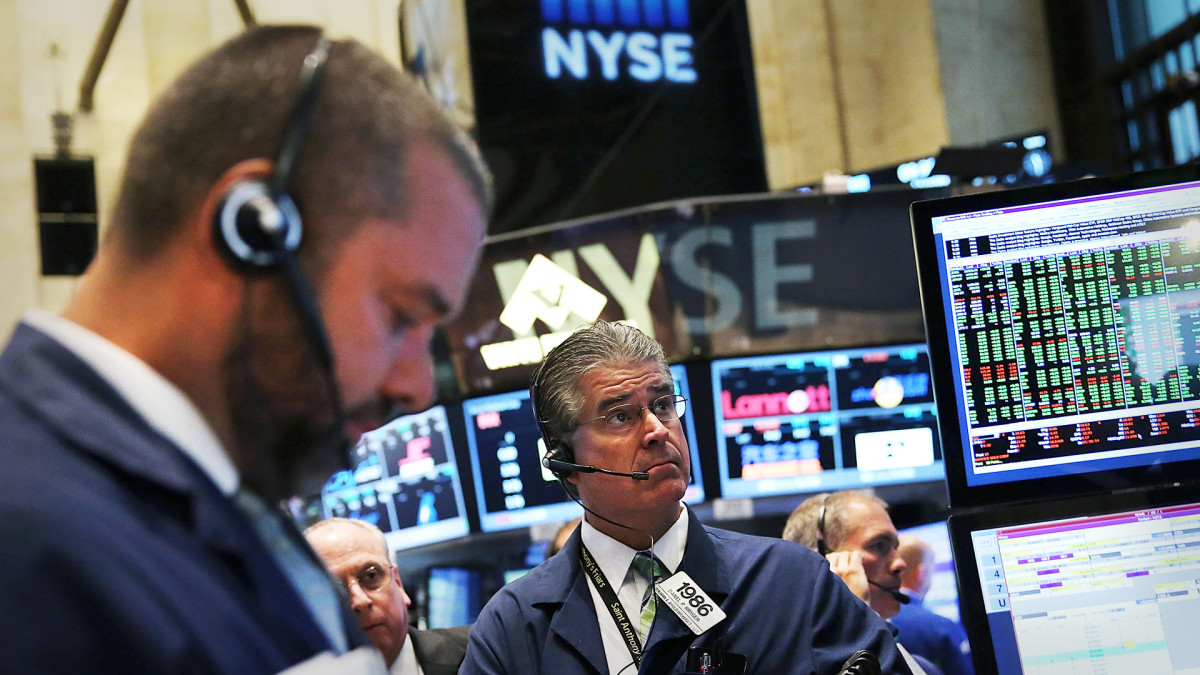
Stocks finished mixed Friday, with the Dow climbing over 500 points, as investors focus through key inflation data.
The Dow Jones Industrial Average surged 574.84 points, or 1.51%, to end at 38,686.32, while the S&P 500 gained 0.80% to 5,277.51 and the tech-heavy Nasdaq slipped 0.01% to 16,735.02, companies like Nvidia lost ground.
The S&P 500 and Nasdaq snapped five-week win streaks with slides of 0.51% and 1.1%, respectively, according to CNBC, and the Dow slipped 0.98% for a second straight week of losses.
Jeff Buchbinder, chief equity strategist for LPL Financial, said that "the technology sector was all the rage last week thanks to strong results from AI darling Nvidia."
"With strong earnings, booming AI growth, and technical momentum, technology is a sector we believe it is prudent to maintain sizable exposure to (it is the largest sector in the S&P 500)," he said.
"But elevated valuations and the concentration of a few mega cap leaders heighten the potential for volatility and the potential for market rotation," Buchbinder said.
LPL's analysts currently recommend a neutral allocation to technology, he added "though it is one of our favorite neutral sectors, along with industrials, and one we would potentially upgrade on weakness depending on the macro environment."
The Bureau of Economic Analysis's PCE Price Index, the Federal Reserve's preferred measure of inflation, showed core prices held at 2.8% last month, matching Wall Street's forecast and readings over the past two months, all of which were the slowest since March 2021.
Markets often key on the bureau's core PCE price index, which the Fed considers a more accurate representation of consumer-price pressures since it blends changes in spending patterns
"We suspect rate cuts will only commence in 2025 when there is greater scope for YoY core PCE inflation to appear to be tracking back towards 2%," said David Doyle, head of economics at Macquarie. "However, should the labor market weaken more than is desirable (and more than we anticipate) this could prompt earlier FOMC action."
Updated at 11:14 AM EDT
Red wash
Stocks are turning lower into the late-morning session, with the S&P 500 down 25 points, or 0.48%, and the Nasdaq falling 186 points, or 1.11%. The Dow was last up 36 points following the April PCE inflation report.
“Investors have been hoping that the bout of inflation we saw early in the year would fade, and that seems to be playing out," said David Russel, global head of market strategy at TradeStation.
"The PCE data confirms price increases aren’t as sticky as feared, keeping hopes of at least one rate cut on the table," he added. "This could set markets up for a more confident tone heading into next week – especially with the ECB expected to cut. Slowly but surely, the inflation saga is fading.”
Per the Bloomberg table below, this morning's US economic numbers, including what is widely seen as the Federal Reserve's preferred inflation metric, were in line with the consensus forecasts…with one exception — that of consumer spending which came in weaker than expected. pic.twitter.com/6iK4FuE2Rr
— Mohamed A. El-Erian (@elerianm) May 31, 2024
Updated at 9:38 AM EDT
Muted open, but modest gains
The S&P 500 was marked 8 points, or 0.16% higher in the opening minutes of trading while the Dow added 137 points following the modestly softer April PCE inflation report. The Nasdaq was marked 7 points higher, or 0.07%.
"The numbers came in exactly as expected. A data-dependent Fed probably did not learn much the past two days," said Scott Helfstein, SVP and head of investment strategy at Global X.
"But the markets continue reducing expectations for rate cuts on economic strength,” he added.
S&P 500 Opening Bell Heatmap (May 31, 2024)$SPY +0.20% 🟩$QQQ +0.09% 🟩$DJI +0.10% 🟩$IWM +0.24% 🟩 pic.twitter.com/TexlKXOmPb
— Wall St Engine (@wallstengine) May 31, 2024
Updated at 8:54 AM EDT
Inflation progress ... sort of
The Fed's preferred inflation gauge eased modestly last month, with core pressures rising 0.2% and the year-on-year reading holding at 2.8%, suggesting at least a morsel of progress in the Fed's fight to slow consumer price pressures.
Stock futures moved firmly higher following the data release, with futures tied to the S&P 500 suggesting a 20 point opening bell gain and those linked to the Dow Jones Industrial Average indicating a 97 point advance
Benchmark 10-year note yields eased 3 basis points to 4.526% following the release, while 2-year notes eased to 4.918%.
The U.S. dollar index, which tracks the greenback against a basket of six global currencies, was marked 0.27% lower at 104.431.
2.75% Core PCE is the lowest since March 2021 pic.twitter.com/WIL0HfhkOW
— Mike Zaccardi, CFA, CMT 🍖 (@MikeZaccardi) May 31, 2024
Check back for updates throughout the trading day
Stocks ended lower again last night, pulling the Dow more than 330 points into the red and extending the average's worst weekly performance in more than a year. investors closely tracked bond-market movements that suggest renewed inflation risks tied to a resilient economy.
First-quarter GDP data, however, provided some test to that thesis, as the Commerce Department's second estimate of first-quarter growth slipped to 1.3% from an original estimate of 1.6%, while inflation pressures muted slightly. That latest figure is the slowest growth since 2022.

Getty/TheStreet
The Bureau of Economic Analysis will publish its benchmark PCE Price Index for the month of April, the Federal Reserve's preferred inflation gauge, at 8:30 a.m. Eastern time. Economists are looking for the core reading to hold at 0.3% on the month and 2.8% on the year.
Bond markets will be acutely reactive to the data release, following a week in which benchmark 10-year note yields hit a one-month high. Stocks likely will trade in tandem as market-volatility gauges test the highest levels since late April.
Related: Bonds are freaking out about inflation
Benchmark 10-year-note yields were last seen trading at 4.56% heading into the start of the New York session, while 2-year notes held at 4.951%. The dollar index was little changed against a basket of its global peers at 104.686.
On Wall Street, futures tied to the S&P 500, which is sitting on a monthly gain of 3.97%, are priced for a modest 12-point decline. Those linked to the Dow Jones Industrial Average suggest a 33-point dip.
The tech-focused Nasdaq, which had its biggest loss of the month yesterday but is still up 6.9% since the end of April, is called 70 points lower.
Stocks on the move in premarket trading include Dell Technologies (DELL) , which tumbled 15.25% to $144 after the PC and server maker posted a mixed set of fiscal-first-quarter earnings and cautioned that profit margins would suffer from its AI-investment plans.
Gap (GPS) shares, meanwhile, surged 23.7% after the clothing retailer boosted its full-year sales forecast. Better-than-expected first-quarter results included a rebound in sales for its Old Navy brand.
Costco Wholesale (COST) shares edged 1.75% lower even as the bulk discount retailer topped Wall Street forecasts for its fiscal third quarter earnings and reported overall revenue of $58.52 billion.
More Wall Street Analysts:
- Analyst unveils new Nike price target ahead of big summer for sports
- Analysts weigh in on Google-parent Alphabet’s stock after cloud event
- Analysts revamp Disney stock price target after proxy fight
In overseas markets, Europe's Stoxx 600 slipped 0.05% in Frankfurt as investors trading U.S. stocks heading into the April inflation reading, while Britain's FTSE 100 bumped 0.29% higher in London.
Overnight in Asia, the regionwide MSCI ex-Japan index was marked 0.52% into the close of trading while the Nikkei 225 managed to book a 0.2% gain for the month of May with a Friday advance of 1.14%.
Related: Veteran fund manager picks favorite stocks for 2024







